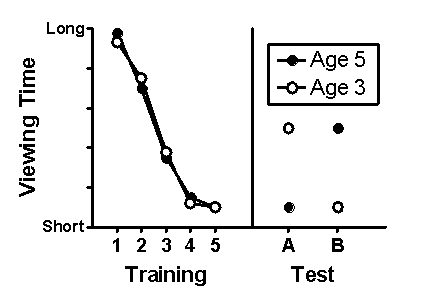Scenario I
Scenario I is based on and presents fabricated results consistent with the following study:
Kim, I. K., & Spelke, E. S. (1992) . Infants' sensitivity to effects of gravity on visual object motion. Journal of Experimental Psychology: Human Perception and Performance, 18(2) , 385-393.
Kim and Spelke (1992) investigated the extent to which infants have expectancies of gravitational effects on visual object motion. Three- and five-month-old infants repeatedly watched a video of a ball accelerating as it rolled down an incline until they spent little time actively looking at it. Subsequently, two types of test trials were conducted in randomized order. Type A test trials consisted of a ball slowing down as it rolled up an incline. Type B test trials consisted of a ball slowing down as it rolled down an incline. During all trials, the amount of time looking at each visual display was recorded. Fabricated data consistent with the major finding of this study are presented in Figure 11.1.
Figure 11.1 
-(Scenario I) Which is the likely explanation for the decreased looking time across training trials?
Definitions:
Q2: (Scenario I) A high-school football coach screams,
Q5: It is important to distinguish between shared
Q10: Babies whose mothers smoke tobacco during pregnancy
Q44: About 70 percent of people with intellectual
Q83: The owner of a restaurant separately asks
Q89: College students who keep their dorm rooms
Q94: Which cognitive ability does not decline as
Q101: Which statement regarding personality factors derived from
Q103: If an Asian American woman is reminded
Q123: The self-concept is most related to the